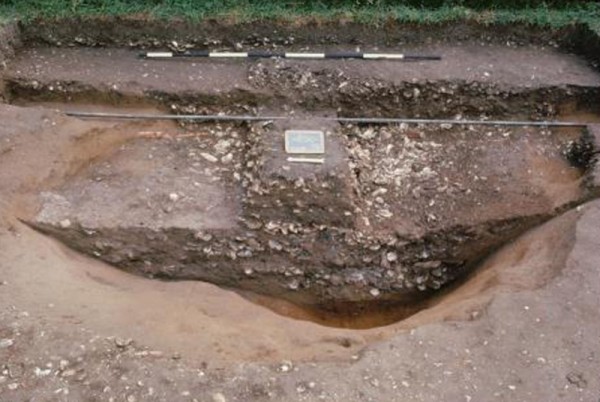
Trash feature at Washington Birthplace, Virginia. Photo: Andrew Edwards.
One of the most enjoyable aspects of my job as an archaeologist for Colonial Williamsburg is the opportunity to work in a public venue. Aside from talking about what I enjoy doing, I get to field questions from our visitors. Just about every day someone will ask “What is the most interesting artifact you’ve ever found?” You’d think that would be a pretty easy question, but after 40-plus years of excavation, I’ve found A LOT of stuff, so the answer requires some thought and is not always the same. It can depend on the age and demeanor of the person asking and my own state of reflection at the time. One such artifact does come to mind…
On a bitterly cold January day in 1975, I was in the process of excavating a pit full of eighteenth-century garbage. It was located about twenty feet from the spot where George Washington was born on Virginia’s Northern Neck. The trash in the pit was likely deposited there in the second quarter of the eighteenth century some years after Washington’s birth in 1722 and was chock-a-block full of refuse. In addition to oyster shell and animal bone, there were 5,119 colonial-period artifacts and 103 deemed Native American. The colonial material included two “И. Pope 1715” wine bottle seals[1], ceramics, pins, buttons, glass and other kitchen-related debris. Much to my surprise, it also contained a tin-plated copper finger ring. The tin plating was corroded and fragile, so I put it in a vial with padding and mailed it off to the William and Mary conservation lab since I was working for the College at the time.
A poesy ring available for sale today at williamsburgmarketplace.com
Aside from obviously thinking what a cool artifact it was, I forgot about the ring until I received a call from the College’s conservator. He told me that the tin plate was not salvageable, but that there was an inscription on the inside of the ring: “Love is a Jest”. Well, it was found in a pit full of trash. Not terribly surprising that a gift (?) with such sentiment would wind up discarded with the soup bones and broken glass, but it did what archaeology should do: it made me think about the people responsible for all that trash and what their daily lives were like.
A little research found that “poesy” rings were common from the 16th through the 19th centuries and can still be bought today – even at the silversmith’s shop in Williamsburg’s Historic Area. They generally carry more endearing messages, like “You and No Other” or “No Treasure Like a True Friend”, but the “Love is a Jest” phrase debunking love was not without precedent:
In poetry: From Amasia, or, The works of the muses a collection of poems: in three volumes (John Hopkins, c.1700)
Such Jugling Tricks I cannot understand;
You hold, unhurt, Coals burning in your Hand.
Long may you sport in the false Am’rous fit;
Love is a Jest, I ne’er could laugh at yet.
And:
From Matthew Prior’s “Moral of a Tale to a Gentleman in Love”:
Whilst men have these ambitious fancies,
And wanton Wenches read Romances,
Our Sex will – What? Out with it, Lie;
And theirs in equal strains reply.
The moral of the Tale I sing,
(A Poesy for a Wedding-Ring)
In this short verse will be confin’d;
Love is a Jest, and Vows are Wind.
There is also a song, Love is a Jest, written by British composer, John Eccles in 1696.
A bit more positive “Hope is the Life of Love” is the inscription in this modern poesy ring. The laments of unrequited love seem to be universal through the ages. In this case archaeology shines a light on an exemplary case from nearly 300 years ago.
Contributed by Andrew Edwards, Staff Archaeologist.
[1] Nathaniel Pope was a neighbor of the Washingtons and the man for whom Pope’s Creek is named. We’ve found several bottle seals from the time period that used a backwards “N”.
Thank you for the information